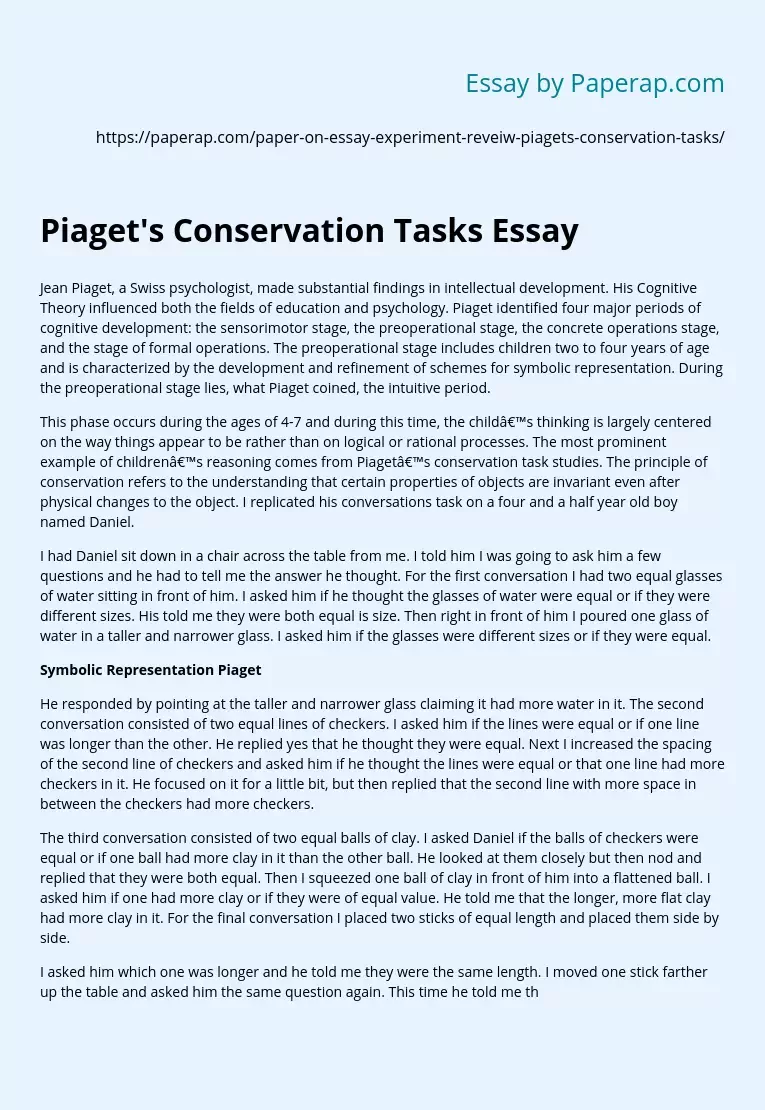Piaget's Conservation Tasks Essay
Jean Piaget, a Swiss psychologist, made substantial findings in intellectual development. His Cognitive Theory influenced both the fields of education and psychology. Piaget identified four major periods of cognitive development: the sensorimotor stage, the preoperational stage, the concrete operations stage, and the stage of formal operations. The preoperational stage includes children two to four years of age and is characterized by the development and refinement of schemes for symbolic representation. During the preoperational stage lies, what Piaget coined, the intuitive period.
This phase occurs during the ages of 4-7 and during this time, the child’s thinking is largely centered on the way things appear to be rather than on logical or rational processes. The most prominent example of children’s reasoning comes from Piaget’s conservation task studies. The principle of conservation refers to the understanding that certain properties of objects are invariant even after physical changes to the object. I replicated his conversations task on a four and a half year old boy named Daniel.
I had Daniel sit down in a chair across the table from me. I told him I was going to ask him a few questions and he had to tell me the answer he thought. For the first conversation I had two equal glasses of water sitting in front of him. I asked him if he thought the glasses of water were equal or if they were different sizes. His told me they were both equal is size. Then right in front of him I poured one glass of water in a taller and narrower glass.
I asked him if the glasses were different sizes or if they were equal.
Symbolic Representation Piaget
He responded by pointing at the taller and narrower glass claiming it had more water in it. The second conversation consisted of two equal lines of checkers. I asked him if the lines were equal or if one line was longer than the other. He replied yes that he thought they were equal. Next I increased the spacing of the second line of checkers and asked him if he thought the lines were equal or that one line had more checkers in it. He focused on it for a little bit, but then replied that the second line with more space in between the checkers had more checkers.
The third conversation consisted of two equal balls of clay. I asked Daniel if the balls of checkers were equal or if one ball had more clay in it than the other ball. He looked at them closely but then nod and replied that they were both equal. Then I squeezed one ball of clay in front of him into a flattened ball. I asked him if one had more clay or if they were of equal value. He told me that the longer, more flat clay had more clay in it. For the final conversation I placed two sticks of equal length and placed them side by side.
I asked him which one was longer and he told me they were the same length. I moved one stick farther up the table and asked him the same question again. This time he told me that the stick that was farther up the table was longer than the other stick. Daniel was obviously in the stage of preoperational because he could not understand the idea that I was not manipulating the amount of objects just changing the appearance. Once Daniel is able to understand this concept he will be able to move into Piaget’s concrete operational stage.
In the concrete operational stage the child is now mature enough to use logical thought or operations (i. e. rules) but can only apply logic to physical objects. During this stage Piaget’s law of conservation and reversibility come into play. This means that the child will learn that when an appearance of a substance has changed it can return to its original stage and that if a given quanity of matter remains the same if it is rearranged or changed in its appearance as long as nothing is added or taken away. Piaget’s law of conservation was evident in my experiment with Daniel as well.
His law concludes that child’s ability to see that some properties are conserved or invariant after an object undergoes physical transformation will not be evident in children under the age of 7. Daniel could not understand that when an object of matter or changes in shape or appearance it does not change the amount of matter in a whole. When a child can conserve he or she is able to reverse the transformation mentally and understand compensation. This experiment has really helped me understand Piaget’s law of cognitive development and law of conservation with a hands on experiment that proves Piaget’s laws.
Piaget's Conservation Tasks Essay. (2019, Dec 05). Retrieved from https://paperap.com/paper-on-essay-experiment-reveiw-piagets-conservation-tasks/

